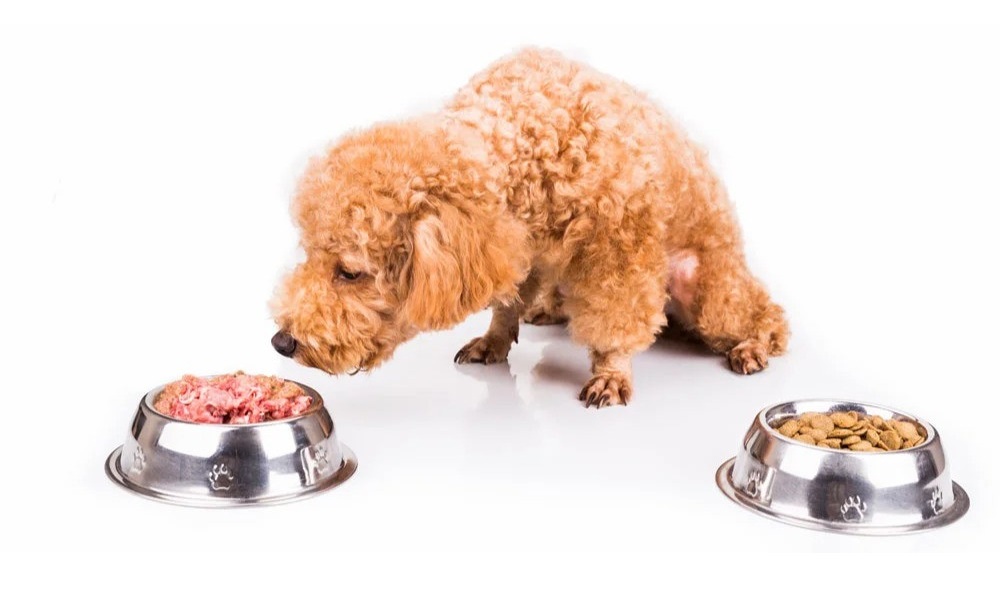Yes, you can mix raw food and kibble for dogs, but it’s vital to do so carefully. This combination requires understanding your dog’s nutritional needs and consulting with a veterinarian.
Mixing raw food and kibble for dogs is a topic of interest to many pet owners looking to diversify their pets’ diets. Combining these two can provide a varied nutritional profile and possibly enhance enjoyment for your dog.
Nevertheless, this approach demands careful consideration of the differing digestibility rates of raw food and kibble, potential bacterial contamination risks, and ensuring a balanced diet is maintained.

Pros Of Mixing Raw Food And Kibble
In the quest for optimal canine health, pet owners often explore various dietary options. A popular topic of interest is whether mixing raw food with kibble benefits our four-legged companions.
Indeed, this approach can harness the nutritional strengths of both diets. Let’s delve into some advantages of this hybrid feeding strategy.
Balanced Nutrition
Combining raw food with kibble could lead to a more balanced diet for your dog. Raw food often contains high levels of proteins and fats, which can be beneficial for your dog’s muscle development and energy levels.
When mixed with kibble, you ensure that your dog also gets the necessary carbohydrates, vitamins, and minerals that may be less abundant in raw food. This combination helps cover a wider spectrum of nutritional needs.
| Raw Food Benefits | Kibble Benefits |
|---|---|
| High in protein and fats | Inclusive of essential carbs |
| Contains natural enzymes | Fortified with vitamins and minerals |
Variety Of Flavors And Textures
Diverse tastes and textures can make mealtime more exciting for dogs. Raw food offers a chewy and juicy experience that most dogs find irresistible, while kibble provides a satisfying crunch.
By integrating raw food with kibble, your dog enjoys a stimulating and enriching eating experience. This variety can also be very beneficial for picky eaters, encouraging them to eat more and enjoy a range of different flavors.
- Raw: Chewy and moist
- Kibble: Crunchy and dry
Cons Of Mixing Raw Food And Kibble
Mixing raw food and kibble might seem ideal, but it often leads to complications. Dogs process these food types differently. This mismatch can cause health issues.
Digestive Upset
Raw food and kibble digest at different rates. Kibble takes longer to break down. Raw food moves faster through the digestive system. They confuse the stomach, leading to:
- Stomach pain
- Bloating
- Gas
- Irregular stool
Increased Risk Of Foodborne Illness
Raw diets can include bacteria like Salmonella or E. coli. When mixed with kibble, these bacteria have a chance to thrive longer in the digestive tract.
| Raw Food Risk | Kibble Risk |
|---|---|
| Bacteria presence | Delayed digestion |
| Quick passage | Bacteria growth |
Tips For Safely Mixing Raw Food And Kibble
Many dog owners explore the benefits of mixed diets. Combining raw food with kibble can provide diversity in nutrition. But, it’s crucial to do it safely. Here are expert tips for a safe mix.
Consulting With A Veterinarian
Before starting a mixed diet, discuss it with your vet. Different breeds may react uniquely to diet changes. Your vet can advise on the best approach for your furry friend’s health.
Gradual Transition
To avoid digestive issues, introduce the new diet slowly. Begin with a small amount of raw food mixed with the kibble. Increase the raw portion gradually over several weeks.
Proper Food Handling
Raw food requires careful handling. Wash your hands thoroughly after touching raw meat. Clean all surfaces and bowls to prevent bacteria spread.
- Store raw food correctly to prevent spoilage.
- Separate raw food from other foods in your fridge.
- Use separate utensils for raw and cooked foods.
| Week | Kibble | Raw Food |
|---|---|---|
| 1-2 | 75% | 25% |
| 3-4 | 50% | 50% |
| 5-6 | 25% | 75% |
Adjust portions based on your dog’s response. Always ensure fresh water is available. This blend could offer a balanced feast for your pet’s delight and nourishment.
Conclusion
The answer is yes, you can mix raw food and kibble for dogs. There are a few things to keep in mind though.
First, make sure that the ratio of raw to kibble is about 50/50. You don’t want to give your dog too much of one or the other.
Second, introduce the new food slowly. Start by mixing a little bit of raw food in with their kibble and gradually increase the amount over time.
Lastly, pay attention to how your dog reacts to the new food. If they seem to be having any digestive issues, stop feeding them the raw food and talk to your vet about other options.
Frequently Asked Questions
Can I Feed My Dog Kibble In The Morning And Raw At Night?
Yes, you can feed kibble in the morning and raw at night. Monitor your dog’s digestion and overall health.
How To Balance Raw Food And Kibble?
Balance raw food and kibble by feeding them separately to aid digestion. Introduce raw food gradually. Consult your vet.
How Much Raw Food And Kibble Should I Feed My Dog?
Feed your dog 2-3% of its body weight daily. Split between raw food and kibble based on vet advice.
Can You Feed A Dog A Mix Of Raw And Cooked Food?
Yes, you can feed a dog a mix of raw and cooked food. Ensure meals are balanced and safe. Consult your vet.
Can You Mix Raw And Kibble Dog Food?
Yes, you can mix raw and kibble dog food safely.